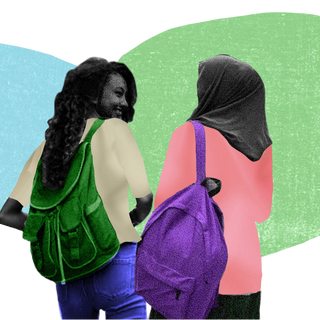
Why We Need to Re‑Examine ‘Brownness’ as an Identity Marker
“Brownness” is presented online as a reclamation of identity, but it fails in its shallow interpretations of decolonization that cater to the Western gaze.

“Brown” invokes many things at once. Brown representation. Brown girl magic. Badass betis. Apu from The Simpsons. Outrage about Apu from The Simpsons. Subtle Curry Traits. History pages on Instagram featuring black-and-white photos of South Asians. More often than not, lately, the idea of Brownness invokes an aesthetic of resistance. It is supposedly a decolonizing project to claim Brownness proudly. It is the empire writing back, speaking back, Instagramming back.
But in trying to do that, conversations about Brownness often become self-defeating – they carve out spaces catering to the White gaze, attracting White-guilt-induced validation. In other words, conversations about Brownness claim to encompass South Asians as a homogenous group while speaking only to Whiteness; it reproduces an orientalist narrative about its culture – one that invokes stereotypical associations of unknowability, mysticism, and discovery.
When Brownness is claimed as an identity, it is usually in the context of relatively privileged desis settled abroad – usually in the US, the UK, or thereabouts. And therein begins the problem. The best Brown representation we haveis Hindu upper caste representation, assimilated nearly completely into American culture. Under the auspices of Brown representation, authenticity can be claimed just by being present as a Brown-skinned person in a predominantly White environment.
A cursory glance through Instagram shows that Brownness is equated with an amorphous, purely aesthetic, vague definition of culture that begins at spices and ends up somewhere near sarees. In most popular representations, Hindu-ized icons like the bindi, idols of gods and goddesses (Kali is a popular example), and other signifiers like the mangalsutra and even the janeu are romanticized as speaking to the “richness” of Brown culture – when in fact, they speak to a violent Brahminical culture. This not only ensures that “Brown” (often interchangeable with “desi”) essentially stands for Hindu (and Sikh in some instances) but also mostly upper caste and insistently apolitical.
Related on The Swaddle:
‘The Simpsons’ Actor Who Voiced Apu Apologizes to Indians for Stereotypical Portrayal
Even basing Brownness as an identity around the least common denominator – the general color of South Asian skin – is fraught with erasure. How brown is too brown? Instagram artists who have infused their work with the idea of Brownness have often used darker skinned, working class Indians as backdrops centering their more palatable, lighter skinned selves, all while waxing eloquently about the “homeland” and “heritage.”
The aesthetics of a culture are often the most visible part of it – but discourse around Brownness equates the privileged aesthetic of Brownness to culture itself. The problem with this is that it flattens an impossibly complex demographic into one that is legible to the “colonizers”.
The celebration of aesthetics as a victory for South Asian representation was most visible recently in Bridgerton’s second season, where Brownness was front and center. The two main Indian characters – Kate and Edwina Sharma – were such melting pots of Brown culture that they hailed from Bombay, addressed each other in Bengali, claimed to know Hindi, and called their father the South Indian word Appa. Although this is only the beginning of what could have been a nuanced portrayal of South Asians but once again, the emphasis on aesthetics cemented a romanticization of upper caste aristocracy and turned them into pop culture icons that celebrate our “heritage” today.
Never Have I Ever too received similar uncritical praise for its representation of Brownness. The Mindy Kaling production – that is said to have marked “us” officially making it big – tells the story of Devi, an Indian teenager in an all-American high school and her hormonal travails. Devi’s story is, by itself, ordinary and refreshing. The attempts at exploring her “culture” – not so much. There is a moment in the first season where Devi wearing a blue half-saree is called Princess Jasmine by a little girl, whose parents ask her for pictures. It is an unintentionally meta moment – critiquing the orientalist gaze of Americans, while using exactly the same kind of easy, uncomplicated reductionism to make the story palatable for an American audience. Those with Indian accents sound exactly like Apu – perhaps because the actors themselves have American accents in real life. It’s not so much depicting a culture as “complicated” as it is lazy – reducing Indianness to upper caste Hinduism and stereotypes about complicated parental relationships.
Related on The Swaddle:
Mindy Kaling’s ‘Never Have I Ever’ Caricatures Indianness, Glorifies Clichés
The Brown narrative is also sprinkled in with popular buzzwords like “colonization” and “decolonization.” But the missing link is that there are no stated goals as to who or what needs decolonizing, or why, or even what decolonization means. Rather than addressing the material consequences of colonization – poverty, inequality, disease, among others – the brownness fad limits decolonization to aesthetics that make little tangible difference to people’s lives. Now, mere vague visuals of the ritualistic aspects of Hinduism have begun to be acknowledged as Brown culture and, by extension, a decolonizing project. The implicit idea is to tackle the inferiority complex by exalting our culture as beautiful, rich, and worthy. But reinforcing upper caste norms as Brownness, taking pride in it, and framing it in the language of decolonization only achieves the opposite: cementing the colonization of caste hierarchies and obscuring its violence under a noble guise.
While trying to exalt Brownness, there is also a tendency to unearth narratives from the archives that paint a picture of India as free and progressive before the British arrived with their Victorian mores. But the part that goes unmentioned is the thousands of years of caste oppression inscribed by scriptural doctrine.
Even just within the South Asian community abroad, the people who make the loudest claims to Brownness are usually not the working class people from South Hall or small shop owners from New Jersey. These calls also do nothing to help impoverished South Asians by way of healthcare, political campaigning, debt forgiveness, access to education, or advocating for food security. Stanning Kamala Harris’ ascension to the Vice Presidency, for instance, was as political as the Brownness project got. That, too, only because she represented the least political kind of Brownness – performing Brownness by looking and sounding right but without any meaningful action that tangibly addresses South Asian issues like colorism, casteism, and inequality. In other words, her being a visibly Brown person in a position of power is enough cause for celebration.
Indians in America have also been known for their silence on systemic racism against other Asians or against black people – a fact that reinforces the disingenuousness of celebrating Brown culture without firmly rooting it in any kind of solidarities across ethnicities. Moreover, Brownness doesn’t provide an adequate framework to have conversations about casteism in the workplace or in universities – arguably showing that it was never meant to encompass the real issues that many “brown” people suffer from. Recently, the founder of Equality Labs, Thenmozhi Soundararajan, was uninvited from a talk about caste at Google, owing to employees’ fears and prejudices. Soundararajan – by all accounts a Brown woman in the United States – faced discrimination from fellow Brown people. There was, however, no mobilization around the incident from the larger “Brown” community abroad – showing its inherent toothlessness as a supposedly cultural and political discourse.
The rootless-ness of Brownness predominantly lies in how it defines and dilutes “culture” as something that can be seen, tasted, and touched. The best and most badass kind of Brownness is one with a slight edge – wearing a saree with sneakers, for instance, or a bindi with a backless dress. In short, the kind of Brownness that is advocated for in mainstream cultural discourse is part of a Savarna Indian imagination – one that colonizes within, and claims to be colonized outside; one that asks to be acknowledged, but only by those it calls colonizers.
Brownness thus pretends to be a tool to talk about colonization while itself hiding the colonization within – that of upper caste Hindus in India who derive their social, political, and cultural capital off the labor and exploitation of marginalized castes in the country.
To say that we need to retire Brownness, then, would be a misstatement – because Brownness never was. “Brown” people don’t have a shared history to speak of, least of all a shared oppression to mobilize around or advocate against. Decolonization cannot be achieved from an idea that is perpetuated by people who are themselves colonizers by caste in what they lovingly call the “homeland.”
Rohitha Naraharisetty is a Senior Associate Editor at The Swaddle. She writes about the intersection of gender, caste, social movements, and pop culture. She can be found on Instagram at @rohitha_97 or on Twitter at @romimacaronii.
Related


In Conversation: On the Misinformation That Led to a Journalist’s Arrest
